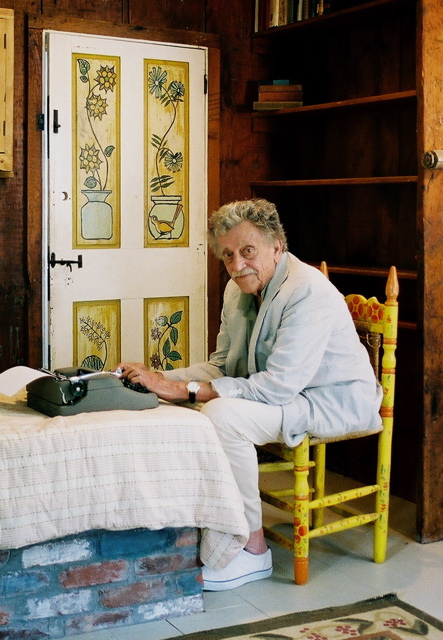
A mentor led the future author on a life-changing wilderness trek — paid for by a quiet barter deal
The story of Kurt Vonnegut, a youthful hunter, trapper, and amateur scientist, sleeping under the stars in West, involves a ghost — the narrator of Galapagos, Vonnegut’s fourteenth novel, published many years later in 1985.
The ghost is Leon Trotsky Trout, who tells us that over the course of a million years, descendants of cruise ship passengers stranded on Galapagos evolved into furry mammals resembling seals. A bacterial disease had destroyed the human race — except for the marooned vacationers: an Indiana schoolteacher, Mary Hepburn; another passenger, James Wait; a fur-covered mutant: Akiko Hiroguchi, whose mother survived the bombing of Hiroshima; and an old sea captain named von Kleist. A strange tale!
With deep affection, Vonnegut dedicated Galapagos in memory of Hillis L. Howie.
Who was Hillis Howie? Why would Vonnegut honor him by laying at his feet this piece of fiction with overtones of H.G. Wells’ fantasy The Island of Dr. Moreau?
?He was a darling man,” Vonnegut told me. In the late 1930s, Howie led a group of young men, including Vonnegut, into the wilderness of the West on what became, for Kurt, an unforgettable adventure and inspiration.
* * *
When Vonnegut was in primary school in Indianapolis, he attended the Orchard School, a private school for upper-middle class children. Vonnegut loved it there. He had responsibilities and others depended on him. He joined with classmates in caring for Billy the goat; running the school library; operating the goodies store; even managing a student savings bank. At lunchtime, all the children, the youngest to the eldest, stood at their place and sang, “We gather together to ask the Lord’s blessing…” Then a few hurried between the kitchen and tables as waiters.
Watching over the school was headmaster Hillis Howie, a benevolent man who fostered individual ability and respect for self and others. He was a Deweyite in the era of progressive education, believing as Aristotle wrote, ?For the things we have to learn before we can do them, we learn by doing them.” So the children built whirligigs while they were studying weather; model ships when the subject was exploration; and planted a garden, which they harvested in the fall, putting fresh vegetables out for lunch they had raised themselves.
Howie’s pied piper influence never left Vonnegut: ?The value system under which I try to operate relative to animals and plants and the earth and persons with cultures different from mine is one I learned from him.”
Then in 1929, Kurt’s parents lost their money in the Wall Street Crash and removed him from the Orchard School, enrolling him in a public elementary school instead. It broke his heart, and he never forgave them.
* * *
In the summer of 1938, however, when Vonnegut was about to begin his junior year at Shortridge High School, his parents gave him permission to join Howie’s nine-week prairie trek out West.
Howie had been leading his ?summer camps on wheels,” as he called them, for ten years. The first prairie trek enlisted a caravan of Model T’s with canvas water bags hanging off the back. Nine boys had accompanied him, traveling and camping across six thousand miles of country. Seeing how much they enjoyed observing and collecting specimens, on future trips Howie encouraged his band of junior explorers to choose a specialty: mammalogy, ethnology, geology, archaeology, ornithology, herpetology, photography — even journalism. By 1930, the treks had a purpose worthy of Lewis and Clark: the boys were gathering specimens to be placed in the Indianapolis Children’s Museum. One year, they brought back a cast of a dinosaur foot.
Howie’s description of the journey sounded like an advertisement for Pony Express riders:
?The plan is to leave civilization behind and spend the months of July and August in remote and generally unknown regions of the Southwest; to establish temporary camps in sagebrush, pinon, and big timber and at ruin sites, deserted mining towns, and alpine lakes; to investigate the fauna, flora, and geology of each territory; to set a standard of camping which will be a satisfaction to ourselves, and a model to others; to live a physically vigorous life, with a taste of the hardships which the early explorers expected. From this it will be understood that the expedition is not a sightseeing trip nor a deluxe dude ranch.”
Kurt got ready to go. He was about to turn sixteen: tall, very thin, and shy, and living painfully in the shadow of his brilliant elder brother, Bernard, a doctoral student in science at MIT. But now he would be joining five adults and 14 boys, including his best friend, Ben Hitz, whom he had known since Orchard School, on an expedition into the wild, desert country of the Southwest, guided by an almost legendary teacher. Vonnegut decided he would list himself as ?archeologist-mammalogist.” He purchased a wide-brim hat to keep the sun off, a pair of boots, packed some tools, camping gear, and took off.
Ten days later, after having stopped in the Dust Bowl regions of Kansas and Oklahoma, the prairie trek caravan arrived at base camp: Cotton-Wood Gulch, Thoreau, New Mexico.
Howie deliberately ?sought out the remote and generally unknown wilderness regions,” he said in an article for a nature magazine, the Regional Review in 1941. ?Sometimes we pretended that we were the first white men to penetrate these wilds. In many spots, the boys had an opportunity to compare the unspoiled land with country that had been ‘developed.’ We led a simple life, did our own cooking, gathered firewood, sagebrush or buffalo chips for fuel and slept under the stars almost every night. We were providing a pioneer experience for the boys in a frontier part of the nation.”
They traveled west to the Grand Canyon, and then wound north to Mesa Verde, up Pike’s Peak, and around the foothills of the Rockies, collecting and categorizing as they went.
Kurt, who enjoyed hunting back home, trapped a rare type of tawny mouse, then skinned and dried it. (Later, in the army, he mentioned his find to another soldier, who pronounced Kurt’s specimen, ?Meesus Vonnegeesus.”) Howie’s goal was to teach the boys, ?the value of our national parks, national monuments, national forests, Indian reservations and other interesting parts of our public domain.”
Away from the pall of his home life where his parents sometimes quarreled late into the night, and away from his brother’s talk about science that ?bored the shit” out of him, Kurt came into his own. He mounted an outcropping of rock and, pounding his skinny ribcage, let out a Tarzan yell that drew shouts of admiring laughter from the other boys. He was just like them — he belonged.
* * *
When Vonnegut was discharged from the army in 1945, considerably changed in body and spirit by his experiences at the Battle of the Bulge, and the destruction of Dresden where he had been a POW, he enrolled at the University of Chicago on the GI Bill. He had no idea which degree to seek. An adviser convinced him he would enjoy anthropology, a ?science that was mostly poetry,” as Kurt understood it.
He worked hard, writing long papers, and tried to recapture some of his adolescent excitement about primitive societies, Indians, and nature. But he felt excluded and condescended to. When the department rejected his proposal for a masters dissertation about similarities between Cubist and Native American art, he halfheartedly started another research project, but a few months later, he dropped out and never re-enrolled. His revenge, in a sense, when he published “Galapagos,” his fantasy about an evolutionary marriage of humans and animals, was to dedicate it to Hillis L. Howie, ?a good man.”
Did Vonnegut know how his father had found the money during the Great Depression to send his awkward boy on the life-changing prairie trek? Apparently not; he never mentioned it. Too in debt to afford the expense, Kurt Vonnegut Sr., an out of work architect, drew up plans for Howie for a cabin heated by a wood stove, and bartered them for his son’s fee.
The cabin is still there, above a spring fed valley in northern New Mexico where the Zuni, Hopi and later Navajo peoples have lived for hundreds of years. On clear mornings, you can see the sun rise over the purple and brown hills, just as Vonnegut did when he awoke, young and hopeful about the long summer day ahead.
Charles J. Shields is the author of And So It Goes: Kurt Vonnegut: A Life, the only complete life story of Kurt Vonnegut, one of the most influential, controversial, and popular novelists of the 20th century. The Christian Science Monitor called Shields’ bestselling Mockingbird: A Portrait of Harper Lee “one of the best biographies of 2006.”
One comment about “Kurt Vonnegut’s Prairie Adventure”
What's your view?
You must be logged in to post a comment.





October 30th, 2012 at 6:48 pm
I am a fan of Kurt Vonnegut. Very absorbing tale about a master storyteller.